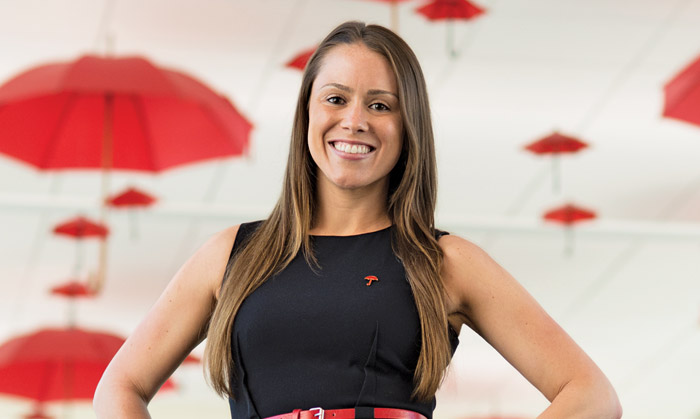
5 Career Trends and the Inspirational Women Leading the Way
In a nod to 2015’s top career and work trends (thanks, Time), here’s a roundup of inspirational women tapping these trends and their stories.
Trend 1: Forget 9-to-5 — flexible freelancing is here to stay
According to a 2014 study by Elance-oDesk, 34 percent of all Americans — 53 million people — are freelance workers. What’s in store for 2015? Career Builder released a forecast that shows growth in freelance opportunities with 23 percent of employers expected to recruit part-time workers due in large part to increased health-care costs associated with hiring full-time talent.
Trendsetter
Sara Sutton Fell is the founder and CEO of FlexJobs, an award-winning service that helps job-seekers find flexible professional opportunities, including telecommuting, freelance, part-time or alternative schedules. A tireless advocate for supporting flexible work environments aimed at achieving societal, environmental and economic benefits, Sutton Fell launched 1 Million for Work Flexibility in 2013. The initiative encourages individual and companies to become one of the million, and in doing so, helps created a platform for change in work flexibility issues. She was named a Young Global Leader in 2014 by the World Economic Forum.
Trend 2: Workplace wellness becomes a priority
In 2015, organizations will invest more in keeping their most valuable assets — employees — as healthy and productive as possible. With that, companies will adopt wellness programs proven to control health-care costs, reduce absenteeism and boost employee morale.
Trendsetter
One of Fortune magazine’s 10 Most Promising Women Entrepreneurs in 2014, Fiona Gathright founded Wellness Corporate Solutions, an organization that provides corporate wellness solutions ranging from health coaching with dieticians and/or fitness trainers to screening and clinical services to more than 500 clients across the country. Not only has she grown the company 644 percent in the past two years and been named to Inc. magazine’s list of fastest growing companies for three straight years, Gathright practices what she preaches. Her organization is consistently recognized as one of the Washington, D.C., area’s healthiest employers and offers daily group exercise options, sit/stand desks and healthy lunches.

Trend 3: Marketing mavens are in demand
According to Time’s 2015 career and workplace trends, marketing jobs will remain plentiful as the media landscape shifts from traditional advertising to content marketing and “native advertising,” especially for marketers who can mine data to inform decisions.
Trendsetter
Shama Hyder, known as the “Zen Master of Marketing” by Entrepreneur magazine, is the founder and CEO of Marketing Zen Group, an online marketing and digital PR firm and the best-selling author of the “Zen of Social Media Marketing.” Her agency, now at 30 full-time employees, helps organizations master digital marketing including social media, search engine optimization and blogging, and regularly disperses marketing wisdom on its blog.
Trend 4: Entrepreneurship goes mainstream for millennials
Millennials, on track to become 75 percent of the global workforce by 2025, are increasingly starting their own businesses. According to the Kauffman Foundation, 54 percent have either started a business or are planning on it.
Trendsetter
Stephanie Newby, founder of Golden Seeds, an early-stage investment firm focused on women-led businesses, shares, “I love backing women entrepreneurs because they are visionaries, smart, hard-working and doing things their way. They are creating companies where values come first, and corporate culture is formed with a strong female influence.” Some of her women-led investments include:
-
Bespoke Global, founded by Gwen Carlton and Pippa McArdle, brings high-end artisan goods from around the world to to your doorstep.
-
Gracious Eloise, founded by Eloise Bune, brings personalized handwritten communications to the masses through handwriting automation.
Trend 5: Recruiting gets rigorous
With the cost of hiring Americans at record highs given increased health-care, workers’ compensation and Social Security costs, companies are scrutinizing candidates like never before. It’s never been more expensive to make a wrong hire.
Enter the “Moneyball approach” to talent management sometimes, referred to as “people analytics” or “workforce science,” which involves applying Big Data to human resources and the search for talent.
Trendsetter
At Microsoft, Dawn Klinghoffer, senior director of HR Business Insights, is charged with creating efficiencies in the hiring process. With attrition rising in the industry, her team began modeling employee data to identify those most likely to leave and began instituting “intervention” best practices including assigning mentors, changes in stock vesting, and increasing salaries. Her team focused on two business units with high attrition rates and in each case reduced rates by more than half.
As adoption of job-matching technologies like Gild, Evolv and Knack grows, women will benefit. Studies show that female applicants face biases that technology can help eliminate.

